Air circuit breaker, vacuum circuit breaker, oil circuit breaker, and gas circuit breaker are four types of circuit breakers on the basis of arc quenching medium or arc extinction medium.
When we switch on or switch off a switch, the arc is formed, this phenomenon happens in every switch. Yes, the formation of the arc depends on the magnitude of the current flowing through the circuit at the time of switching.
It is a necessity that during the making and breaking of the breaker, the arc must be extinguished to safeguard the breaker’s contact. The quick arc quenching is a must at the time of switching off the breaker and during fault clearing. Therefore, a breaker needs the arc quenching medium, such as air, oil, and gas.
When a fault occurs in the electrical system, the fault current must be quickly and reliably interrupted to avoid catastrophic damage to equipment and nearby personnel. This is why circuit breakers are critical links in fault isolation.
All circuit breakers have contacts, and when the contacts separate during the fault clearing they produce an arc. The arc provides a low-resistance path for current, and current flow in the circuit remains uninterrupted until the arc extinguishes.
The electric arc forms between the contacts and spreads in length when the contacts open. For this reason, circuit breakers require a device to control or eliminate the arc.
Types of Circuit Breakers
Based on arc extinction, there are four types of circuit breakers.
- Air circuit breaker
- Vacuum circuit breaker
- Oil circuit breaker
- Gas circuit breaker.
Air Circuit Breaker (ACB)
This type of circuit breaker’s operating mechanisms is exposed to the surrounding environment.
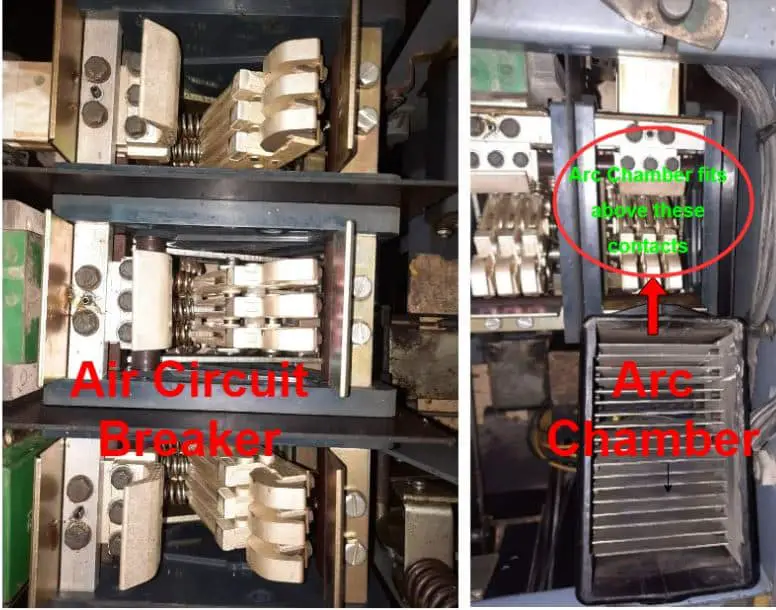
The arc initiation and extinction take place in the static air in which the arc moves.
Types of Air Circuit Breaker (ACB)
The air circuit breaker can be further classified according to the types of air breaking methods. The types of air break circuit breakers are as follows.
- Plain air circuit breaker
- Air Chute Air Break Circuit Breaker
- Magnetic Blowout Type
- Air Blast Circuit Breaker
Plain Air Circuit Breaker
The plain arc circuit breaker has an arc chamber as the main component that quenches the arc. The arc is forced to enter into the arc chute. The design of the arc chute’s inner walls drives the arc into the serpentine channel projected on the arc chute wall.
The arc chute has a number of small compartments made of metals that splits the arc. Thus the arc splitter acts as a mini-arc chute. The initial arc voltage is higher than the system voltage because the initial arc is split into a series of arcs. The plain air circuit breakers are suitable for low voltage applications.
Air Chute Air Break Circuit Breaker
The arc chute is divided into a number of small compartments by using metallic separation plates. Metallic separation plates are arc splitters and each of the small compartments behaves as a mini-arc chute. The initial arc will split into a series of arcs this will make all arc voltages higher than the system voltage. They are a preferable choice in low voltage applications.
The convection air cools and maintains the operating temperature of the breaker’s components within reasonable temperature limits. The spring-loaded actuating system is used to open and close the main contacts through a control switch or relay-type protection that activates the trip command.
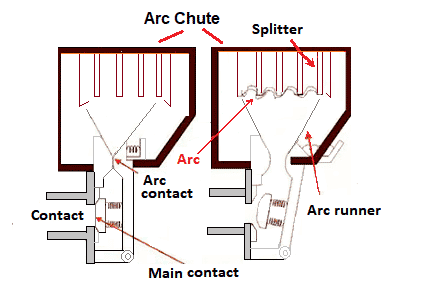
During the interruption of a circuit, an arc is generated by the action of a magnetic field created by coils connected in series. These coils are called exhaust coils because they help in blowing the arc magnetically. The arc is magnetically blown into arc chutes where the arc is stretched, cooled, and extinguished.
The arc-breaking action becomes more effective with strong currents. Consequently, these breakers have higher breaking capacities. The air circuit breakers are used voltage up to 15 kV and fault interrupting capacity up to 500MVA.
Magnetic Blowout Type Air Break Circuit Breaker
The magnetic blowout type ACB has a coil that produces a magnetic field. The magnetic field provides magnetic control over the momentum of the arc and directs the arc towards the arc chute. In the arc chute, the arc gets lengthened, cooled, and extinguished. These types of breakers are suitable for 11KV applications.
Air Blast Circuit Breaker
The air blast circuit breakers are suitable for high voltage up to 420 kV and even more.
There are two types of air blast circuit breaker
- Axial blast breaker
- Axial blast with sliding moving contact.
Axial Blast Air Circuit breaker
The Axial Blast breaker has a nozzle orifice fixed at its fixed contacts. The high pressure produces in the chamber of the circuit breaker at the time of the fault. In this condition, the high-pressure air flows through the nozzles and extinguishes the arc. Thus the breaker contacts separate safely without damage.
Axial blast Air Circuit Breaker with Sliding Moving Contact
The breaker’s moving contact is fitted over a piston supported by a spring. The blast guides the arc towards arcing electrode.
Advantages of Air circuit breakers (ACBs)
- An economical option for voltages up to 1000 V.
- Its construction is simple
- No fire or health hazard.
- High resistance to short circuit and arc interruption capacity.
Disadvantages of Air circuit breakers (ACBs)
- Uneconomical for voltages above 3.3 kV (too high)
- Regular maintenance is essential.
Vacuum Circuit Breaker (VCB)
In the medium voltage range below 35 kV, vacuum circuit breakers are widely used. The vacuum circuit breaker is similar to the air circuit breakers. There is the main difference in contact assembly being enclosed in a vacuum bottle.
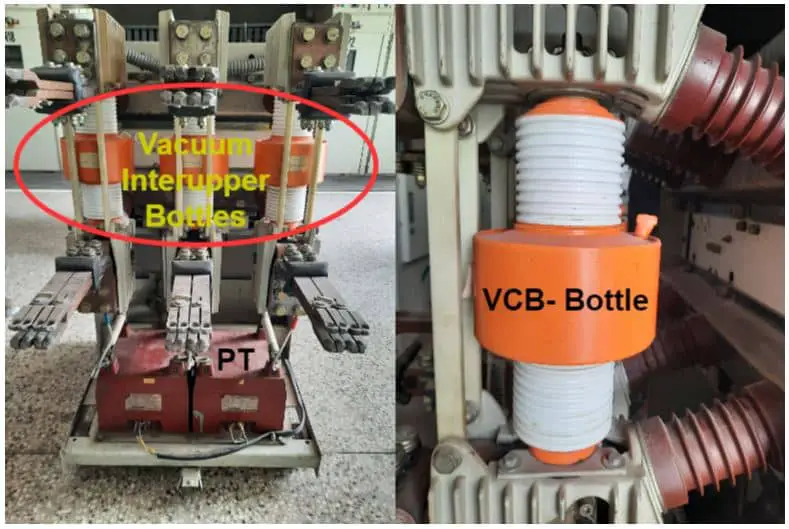
The inner view of the VCB bottle is shown below.

The movable contact assembly consists of a stem, which has a closed contact at one end and a drive mechanism at the other end located outside of the vacuum bottle. The compression springs are provided in connection with the contact assembly in order to separate the moving contact from the stationary contact and apply the necessary force to prevent the contacts from opening inadvertently.
As with air circuit breakers, the actuator can be manually or electrically actuated by trip and close coils, actuated by a protection relay. Like air circuit breakers, medium voltage vacuum circuit breakers in an industrial setting are typical of the draw type.
Advantages of Vacuum circuit breakers (VCBs)
- Extinguish the arc in a sealed container, so that the arc and hot gas are not exposed.
- As an independent component, the arc quenching chamber is easy to install and troubleshoot.
- They are the most popular type of medium voltage circuit breakers for industrial settings due to their compact size and improved reliability compared to air circuit breakers.
- The arc extinction time is short, the arc voltage is low, the arc energy is small, the contact loss is small, and the number of breaking times is large.
Disadvantages of Vacuum circuit breakers (VCBs)
- Deposits that form during switching limit the number of possible operations before maintenance or restoration is required.
- More expensive than other types of circuit breakers.
- There is no practical method available at this stage to observe the vacuum inside the bottle.
Oil circuit breaker
Normally found outdoors, were common in the past. But oil circuit breakers are increasingly rare in the industrial environment, as in mostly replaced by vacuum circuit breakers.
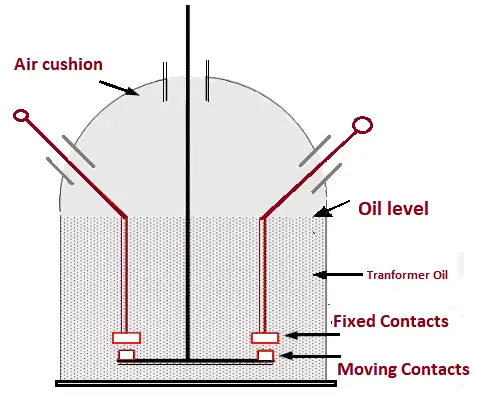
A typical oil-filled circuit breaker includes the same operating characteristics as an air-filled circuit breaker. Oil is a dielectric or insulating medium for arc quenching. In an oil circuit breaker, the circuit breaker contacts are made to separate in the insulating oil. When faults occur, the circuit breaker contacts open under the insulating oil and an arc develops between them, and the heat from the arc evaporates into the surrounding oil.
Oil circuit breakers are two types
- Bulk oil breaker
- Minimum oil breaker
Bulk Oil Circuit Breaker
This type of breaker uses a large quantity of oil for arc quenching, that is why it is called a bulk oil circuit breaker. The oil serves two purposes- arc quenching and cooling. The oil quantity in a bulk circuit breaker depends on the system voltage.
The bulk oil circuit breaker is also called a dead type of circuit breaker because its tank is held at zero potential.
Minimum oil circuit breaker
As its name suggests, it uses minimum oil for arc quenching and cooling. The fixed and moving contacts of the breaker are housed in a sealed chamber, and the chamber is filled with oil. The chamber is mounted on an insulator for electrical isolation from the earth.
Advantages of oil circuit breakers
- The high dielectric strength of the oil provides good insulation.
- The oil acts as a good insulator.
- The oil in the circuit breaker absorbs the energy of an arc when it breaks down.
- The dielectric strength of the oil is high.
- They use less amount of oil.
Disadvantages of oil circuit breakers
- Due to the dissolution of the oil in the arc, the oil becomes contaminated with carbon particles, which reduces the dielectric strength.
- Therefore, periodic maintenance is required.
- The dielectric strength will quickly decrease the amount of oil due to the high amount of carbonization.
- There is a possible risk of the formation of an explosive mixture with air.
- Oil can be flammable and cause a fire hazard if a faulty breaker fails under pressure and causes an explosion.
Gas Circuit Breakers
The arc generated in the gas circuit breaker is extinguished in a chamber filled with pressurized sulfur hexafluoride gas (SF6). It is a non-flammable, inorganic gas that is an excellent electrical insulator.
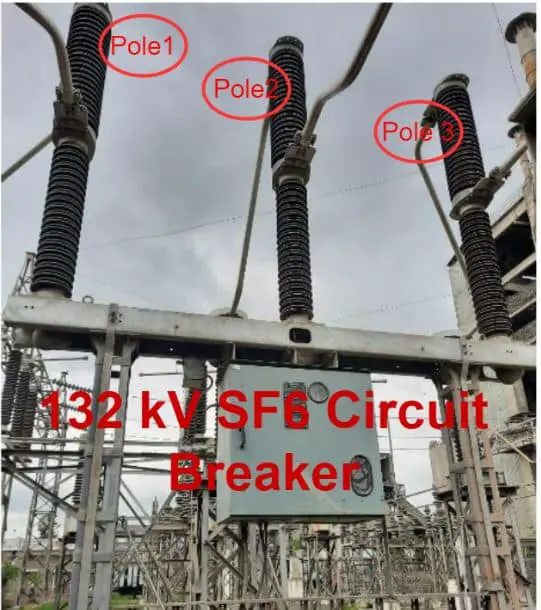
The SF6 circuit breaker is similar to the vacuum circuit breaker. The main difference is that the contact assembly is housed in a pressurized bottle.
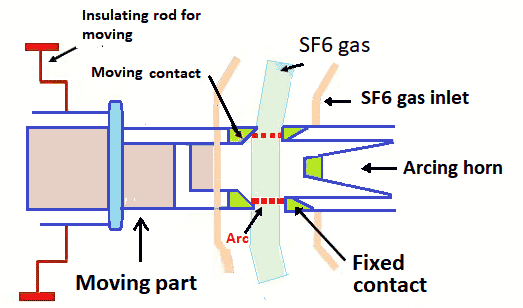
During operation, this highly compressed gas is released through the arc in the circuit breaker, collected in a relatively low-pressure reservoir, and then pumped back to the high-pressure reservoir for reuse.
Advantages of Gas circuit breakers
- The SF6 switchgear is suitable for voltages up to 66 kV for armored switchgear and 800 kV for gas insulated switchgear (GIS).
- The pressure of the SF6 gas can be easily controlled. The insulating medium does not present a fire/explosion hazard.
- These are used almost exclusively in outdoor applications and are increasingly favored over oil breakers due to their lower maintenance costs.
- A distinct advantage that gas breakers have over vacuum breakers is that the gas bottle loses pressure, and the residual SF6 gas may be enough to allow the breaker to open safely under normal load.
Disadvantages with Gas circuit breakers
- The gas of SF6 is its negative effects on the atmosphere as a powerful greenhouse gas.